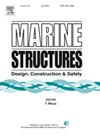基于链-海床相互作用宏观模型的浮式风力机系泊系统分析
IF 5.1
2区 工程技术
Q1 ENGINEERING, CIVIL
引用次数: 0
摘要
传统的浮式风力发电机(fts)的全集成分析假设在海床上有一个固定的系泊点,忽略了在海床内嵌入系泊线的影响。这种简化给系泊系统设计带来了不一致性和不确定性。本文提出了一种模拟锚泊线与海底土体相互作用的宏观模型,并将其应用于全耦合气动-液压-伺服-弹性工程工具SIMA中。宏观模型捕捉了三维空间中增量位移与土反力的耦合非线性关系。在验证模型的基础上,评估了海底摩擦力和锚链对锚泊线的影响。随后,利用宏观模型对支撑IEA 15MW浮式风力发电机的VolturnUS-S浮式船进行了系泊分析,以评估系泊线设计中的关键参数。然后,设计了三个具有代表性的动态工况,研究了内埋线对系泊系统响应的影响。研究表明,锚链-海床相互作用的宏观模型能够有效地捕捉锚链的响应,考虑到土壤反力的逐渐动员和锚链几何结构的有效宽度参数。在不对预埋线进行建模的情况下,锚泊线在海床上靠近平台处的位移较小,因此锚泊线的张力较大,强调了预埋线在静态和动态条件下对海床摩擦动员的重要性。海底摩擦分担了从浮子传递过来的载荷,并对锚载荷有显著影响。本研究为考虑嵌入式链的浮式风力发电机系泊设计提供了一个重要工具。本文章由计算机程序翻译,如有差异,请以英文原文为准。
Analysis of mooring system for floating wind turbine based on macro-model of chain-seabed interaction
Traditional fully integrated analyses of floating wind turbines (FTWs) assume a fixed mooring point on the seabed, overlooking the effects of the embedded mooring line within the seabed. This simplification introduces inconsistency and uncertainty in mooring system design. In this study, a macro-model was proposed to simulate the interaction between the mooring line and seabed soil, and it was implemented into SIMA (a fully coupled aero-hydro-servo-elastic engineering tool). The macro-model captures the coupled non-linear relationship between incremental displacement and resultant soil reaction force in three-dimensional space. After verifying the model, effects of seabed friction and embedded chain on the mooring line were evaluated. Subsequently, mooring analyses of the VolturnUS-S floater supporting the IEA 15MW floating wind turbine were performed using the macro-model to assess key parameters in mooring line design. Then, three representative cases under dynamic conditions are designed to investigate the influence of the embedded line on mooring system response. The study demonstrated that the macro-model of chain-seabed interaction effectively captures the response of the mooring chain considering gradual mobilization of soil reaction forces and effective width parameters due to the chain geometry. Without modelling the embedded line, mooring lines have larger tension due to smaller displacement near the padeye on the seabed, emphasizing the importance of embedded line on seabed friction mobilization under both static and dynamic conditions. The seabed friction shares the load transferred from the floater, and significantly affects the anchor load. This study develops a crucial tool for mooring design of floating wind turbines considering the embedded chain.
求助全文
通过发布文献求助,成功后即可免费获取论文全文。
去求助
来源期刊

Marine Structures
工程技术-工程:海洋
CiteScore
8.70
自引率
7.70%
发文量
157
审稿时长
6.4 months
期刊介绍:
This journal aims to provide a medium for presentation and discussion of the latest developments in research, design, fabrication and in-service experience relating to marine structures, i.e., all structures of steel, concrete, light alloy or composite construction having an interface with the sea, including ships, fixed and mobile offshore platforms, submarine and submersibles, pipelines, subsea systems for shallow and deep ocean operations and coastal structures such as piers.
 求助内容:
求助内容: 应助结果提醒方式:
应助结果提醒方式:


